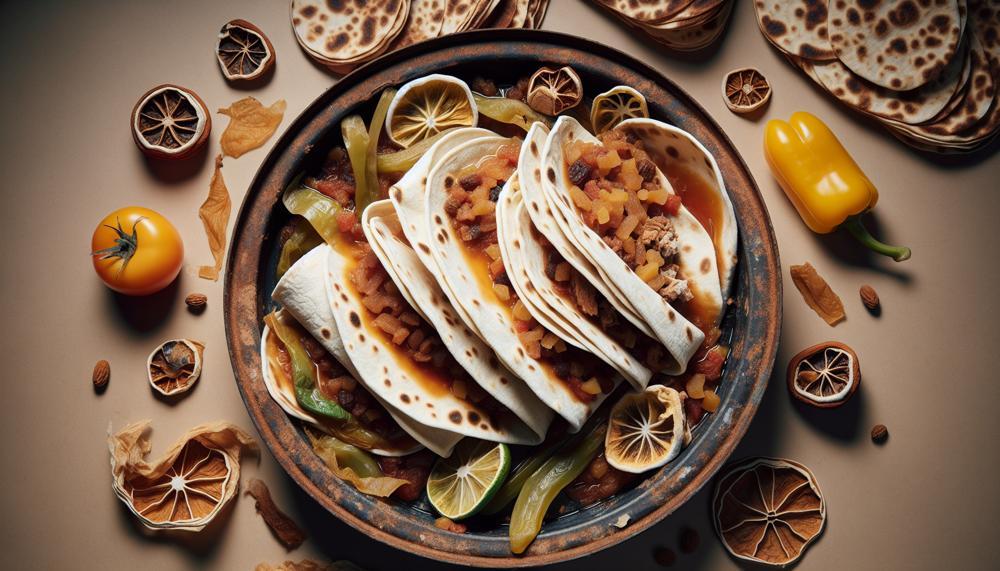Did you know that consuming expired tortillas can have serious health effects and risks? Many people underestimate the potential consequences of eating expired food, but the truth is, expired tortillas can cause a range of problems.
From changes in texture and flavor to digestive discomfort and even the risk of foodborne illnesses, the effects of eating expired tortillas can be more significant than you might expect.
In this article, I will delve into the topic of expired tortillas, exploring their shelf life, signs of spoilage, and the effects they can have on your body.
I will also provide insights into whether it’s safe to eat expired tortillas and share tips on proper storage and handling of tortillas to prevent them from expiring quickly.
Contents
- 1 The Shelf Life of Tortillas
- 2 Signs of Spoiled Tortillas
- 3 Effects of Eating Expired Tortillas
- 4 Can You Eat Expired Tortillas?
- 5 Proper Storage and Handling of Tortillas
- 6 How to Store Tortillas
- 7 Can You Freeze Tortillas?
- 8 How to Use Old Tortillas
- 9 Effects of Consuming Expired Tortillas in Dishes
- 10 Safe Ways to Repurpose Tortillas
- 11 Conclusion
Key Takeaways
- Consuming expired tortillas can lead to changes in texture and flavor, reduced nutritional value, digestive discomfort, and the risk of foodborne illnesses.
- Signs of spoiled tortillas include the presence of mold or fungus, foul odor, sliminess, off-putting taste, physical damage, and an expired expiration date.
- If tortillas have passed their expiration date but still appear and smell good, they may be safe to eat, but it’s best to discard them if there are signs of mold or a foul smell.
- Proper storage and handling of tortillas, such as storing them in a cool and dry environment, using proper packaging, and following hygiene practices, can help prolong their shelf life.
- There are various ways to repurpose old tortillas instead of discarding them, such as using them in traditional Mexican recipes like chilaquiles, migas, or tortilla soup.
The Shelf Life of Tortillas
Tortillas, a staple in many cuisines, have a finite shelf life and can spoil if not stored correctly. The length of time tortillas remain fresh varies depending on the type of tortilla and how they are stored. It is essential to be aware of these factors to ensure their freshness and avoid consuming expired tortillas.
Here is an overview of the general shelf life for different types of tortillas:
Corn Tortillas
- Untouched package: Check the expiration date printed on the package, typically lasting 2 to 3 months from the date of purchase.
- Opened package: Stored in the refrigerator, corn tortillas can last for up to 1 to 2 weeks.
- Frozen: If properly sealed, frozen corn tortillas can maintain their quality for up to 6 to 8 months.
Flour Tortillas
- Untouched package: Check the expiration date on the package, typically ranging from 1 to 2 weeks.
- Opened package: Stored in the refrigerator, flour tortillas can stay fresh for about 1 week.
- Frozen: When adequately wrapped, frozen flour tortillas can retain their quality for up to 6 to 8 months.
These timelines are general guidelines, and it’s crucial to remember that the shelf life can vary depending on the specific brand, storage conditions, and any preservatives used.
Signs of Spoiled Tortillas
When it comes to determining whether your tortillas have gone bad, there are several indicators to watch out for. By being able to recognize these signs, you can avoid consuming spoiled tortillas and protect yourself from potential health risks.
- Mold or Fungus: One of the most obvious signs of spoiled tortillas is the presence of mold or fungus. If you notice any patches of green, white, or black growth, it’s a clear indication that your tortillas have spoiled.
- Foul Odor: Another telltale sign is a foul odor emanating from the tortillas. If they emit a strong, unpleasant smell that is different from their usual aroma, it is a strong indication that they have gone bad.
- Sliminess or Texture Changes: Spoiled tortillas may develop a slimy or sticky texture. If the tortillas feel tacky or have a slimy film on the surface, it’s a sign that they are no longer safe to consume.
- Off-Putting Taste: Taste is an essential factor in identifying spoiled tortillas. If the tortillas have an off-putting taste, such as a sour or bitter flavor, it is a clear indication that they have gone bad.
- Physical Damage: Any physical damage to the tortillas, such as tears, discoloration, or holes, can also be a sign of spoilage. Damaged tortillas are more susceptible to bacterial growth and should be discarded.
- Expired Expiration Date: Finally, always check the expiration date on the tortilla packaging. If the date has passed, it is best to err on the side of caution and assume that the tortillas are spoiled.
By keeping an eye out for these indicators, you can ensure that the tortillas you consume are fresh, safe, and free from any spoilage. Properly identifying these signs is crucial in maintaining food safety and protecting your health.
Effects of Eating Expired Tortillas
Eating expired tortillas can have several consequences for your body, impacting both your taste buds and overall well-being. Here are the potential effects of consuming tortillas past their expiration date:
- Changes in Texture and Flavor: Expired tortillas may lose their softness and become dry or brittle. Additionally, their flavor can become stale or develop off-putting tastes.
- Reduced Nutritional Value: Over time, the nutritional content of tortillas can diminish, leading to a decrease in essential vitamins, minerals, and fiber.
- Digestive Discomfort: Consuming expired tortillas can result in digestive issues such as nausea, abdominal pain, gas, and diarrhea.
- Risk of Foodborne Illness: As tortillas age, bacteria can multiply, increasing the risk of foodborne illnesses, such as salmonella or E. coli infections.
- Allergic Reactions: For individuals with food allergies or intolerances, expired tortillas may trigger allergic reactions, potentially leading to symptoms like hives, swelling, itching, or difficulty breathing.
Given these potential consequences, it is crucial to prioritize food safety and avoid consuming tortillas that have passed their expiration date.
Can You Eat Expired Tortillas?

When it comes to eating expired tortillas, prioritizing food safety is crucial. While it is possible to consume expired tortillas in some cases, it is important to exercise caution and consider certain factors before consuming them.
If tortillas have passed their expiration date but still appear and smell good, they may still be safe to eat. However, it is essential to carefully examine the tortillas for any signs of mold or a foul smell. These indicators can suggest the presence of harmful bacteria or spoilage, which can lead to potential health problems if consumed.
Remember that consuming expired food, including tortillas, can pose risks to your health. Even if the tortillas appear fine, it is recommendable to follow food safety guidelines and consider the risks associated with consuming expired food.
Proper Storage and Handling of Tortillas
When it comes to tortillas, proper storage and handling are key to prolonging their shelf life and preventing expiration. By following a few simple guidelines, you can ensure that your tortillas stay fresh and tasty for longer.
Storage
Store tortillas in a cool and dry environment to maintain their freshness. Exposure to heat and moisture can lead to mold growth and spoilage. Consider the following storage options:
- Keep packaged tortillas in a cupboard away from direct sunlight and heat sources.
- If you have homemade tortillas, store them in airtight containers or resealable plastic bags.
- For long-term storage, consider refrigerating or freezing tortillas.
Handling
Proper handling of tortillas is just as important as storage. Take the following steps to ensure the quality of your tortillas:
- Always wash your hands before handling tortillas to avoid any potential contamination.
- Use clean utensils or gloves when handling tortillas to prevent cross-contamination.
- When removing tortillas from their packaging, be gentle to avoid tearing or damaging them.
Proper storage and handling of tortillas can prolong their shelf life and prevent early expiration. By storing tortillas in a cool and dry environment and handling them with clean hands or utensils, you can ensure their freshness.
To further understand the importance of proper storage and handling, let’s take a look at the table below:
| Tortilla Storage Tips | Benefits |
|---|---|
| Store in a cool and dry environment | Prevents mold growth |
| Use airtight containers or resealable bags | Maintains freshness |
| Refrigerate or freeze if needed | Extends shelf life |
| Wash hands before handling | Avoids contamination |
| Use clean utensils or gloves | Prevents cross-contamination |
| Handle with care | Avoids tearing or damage |
This table highlights the key tips for properly storing and handling tortillas and the corresponding benefits. By following these guidelines, you can ensure that your tortillas stay fresh and delicious, prolonging their shelf life and preventing premature expiration.
How to Store Tortillas
Proper storage is crucial to maintain the freshness and quality of your tortillas, whether they are packaged or homemade. The storage options for tortillas vary based on their type. Let’s explore the different storage guidelines for packaged and homemade tortillas below.
Packaged Tortillas Storage
When it comes to packaged tortillas, you have a few options for storage. Here are the recommended methods:
- Store in a cupboard: Packaged tortillas with a long shelf life, such as those in a sealed bag, can be stored in a cool, dry cupboard. Ensure the area is free from excessive moisture and heat to prevent spoilage.
- Refrigerate: If you want to extend the shelf life of packaged tortillas, refrigeration is a suitable option. Place the unopened package in the refrigerator, making sure it is tightly sealed.
- Freeze: If you have a surplus of packaged tortillas or want to stock up, freezing them is an excellent choice. Freezing helps maintain their freshness for an extended period. Wrap the package tightly with plastic wrap or transfer the tortillas to a freezer-safe bag or container before freezing.
Remember to label the package with the date of freezing to keep track of their freshness. When you’re ready to use the frozen tortillas, thaw them in the refrigerator overnight or use the defrost setting on your microwave. Avoid refreezing tortillas after thawing to preserve their quality.
Homemade Tortillas Storage
Storing homemade tortillas requires specific handling to keep them fresh and delicious. Here’s what you need to do:
- Cooling: Allow the freshly cooked homemade tortillas to cool completely before storing them. This step prevents moisture buildup, which can lead to spoilage.
- Stacking: Stack the cooled tortillas together, making sure there is parchment paper or wax paper between each tortilla. This creates a barrier that helps prevent them from sticking and tearing.
- Proper packaging: Transfer the stacked tortillas to an airtight container or resealable plastic bag. Ensure the container or bag is tightly sealed to maintain freshness.
- Refrigeration: Homemade tortillas have a shorter shelf life compared to packaged ones. To prolong their freshness, refrigerate them. Ideally, use the tortillas within 3-4 days of preparation.
By following these storage guidelines, you can enjoy fresh and tasty tortillas whenever you’re ready to indulge in them.
| Tortilla Type | Storage Options |
|---|---|
| Packaged Tortillas |
|
| Homemade Tortillas |
|
Can You Freeze Tortillas?
Freezing tortillas is an excellent way to extend their shelf life and ensure that they remain fresh for future use. Whether you have store-bought tortillas or homemade ones, freezing is a convenient and practical method to prevent them from going bad. However, proper wrapping and sealing techniques are essential to maintain their quality and texture.
When it comes to freezing tortillas, follow these simple steps to preserve their freshness:
- Choose the right packaging: Wrap each tortilla individually using plastic wrap or aluminum foil. Make sure to remove as much air as possible to prevent freezer burn. Alternatively, you can also store them in airtight freezer bags.
- Seal them properly: Once the tortillas are wrapped, seal them tightly to prevent any moisture or freezer odors from affecting their taste and texture. Ensure that the packaging is secure and intact.
- Label and date: It’s crucial to label the tortillas with the freezing date. This will help you keep track of their freshness and determine when they need to be used.
When you’re ready to thaw the frozen tortillas, it’s best to defrost them gradually in the refrigerator. This slow thawing process helps maintain their texture and prevents any significant changes. If you’re in a hurry, you can also use the defrost setting on your microwave, but remember to handle them carefully to avoid any texture changes.
To summarize, freezing tortillas is a simple and effective method to extend their shelf life. By following proper wrapping and sealing techniques, you can ensure that your tortillas remain fresh and ready to use whenever you need them.
Pros and Cons of Freezing Tortillas
| Pros | Cons |
|---|---|
| Extends shelf life | Potential texture changes |
| Convenient for meal prep | Requires proper wrapping and sealing |
| Prevents waste | Gradual thawing process |
How to Use Old Tortillas
Even if tortillas have become stale, there are various ways to repurpose them instead of throwing them away. Traditional Mexican recipes like chilaquiles, migas, and tortilla soup make great use of old tortillas. These dishes allow you to enjoy your tortillas without wasting them.
Recipes for Old Tortillas
When it comes to repurposing old tortillas, there are countless possibilities. Here are three delicious recipes that will transform stale tortillas into mouthwatering meals:
Chilaquiles:
Chilaquiles is a classic Mexican dish that combines stale tortillas with salsa, cheese, and other savory toppings. Start by cutting the old tortillas into quarters or strips, then fry them until they’re crispy.
Next, simmer the tortilla pieces in a flavorful salsa, adding toppings like cheese, avocado, and cilantro.
With each bite, you’ll savor the perfect blend of textures and flavors.
Migas:
Migas is a Tex-Mex breakfast dish that uses stale tortillas as the base. Begin by tearing the tortillas into small pieces. In a skillet, cook onions, bell peppers, and any other desired vegetables until tender. Add the torn tortillas to the pan and continue cooking until they’re crispy.
Finally, scramble eggs and fold them into the tortilla mixture for a satisfying and filling breakfast.
Tortilla Soup:
Tortilla soup is a comforting and flavorful soup that includes pieces of fried tortillas. To make this soup, start by frying the stale tortillas until crispy. In a separate pot, sauté onions, garlic, and spices for the base of the soup.
Add broth, diced tomatoes, and any desired vegetables or proteins. Once the soup is simmering, garnish each bowl with the fried tortilla strips, avocado, cheese, and fresh herbs.
By exploring these recipes and incorporating your own creativity, you can create delicious meals using stale tortillas. This way, you can reduce food waste and enjoy the flavors of traditional Mexican cuisine.
Effects of Consuming Expired Tortillas in Dishes
When expired tortillas are used in dishes, the consequences can be similar to eating expired tortillas in their original form. The texture, flavor, and potential risks associated with consuming expired tortillas can transfer to the dish, leading to digestive discomfort or even foodborne illness.
Using expired tortillas in cooking can result in a compromised taste and texture of the dish. The expired tortillas may become dry, brittle, or develop an unpleasant taste, which can significantly impact the overall dining experience. Additionally, the expired tortillas may not provide the same level of freshness and quality that would be expected from using fresh ingredients.
Furthermore, using expired tortillas in dishes carries the risk of foodborne illness. Expired tortillas can become contaminated with harmful bacteria, such as Salmonella or E. coli, which can cause digestive issues and other health problems if consumed.
“Consuming expired tortillas in dishes can lead to unpleasant texture, flavor, and potential health risks. It’s crucial to prioritize food safety and avoid using expired tortillas in cooking.”
To ensure food safety and prevent the negative consequences of using expired tortillas in dishes, it is important to check the expiration date before using them. Discard any tortillas that have passed their expiration date or show signs of spoilage, such as mold or an off-putting smell.
By using fresh tortillas in your cooking and following proper food storage and handling guidelines, you can enjoy delicious and safe meals without the risk of consuming expired tortillas.
| Consequences of Using Expired Tortillas in Cooking |
|---|
| 1. Compromised taste and texture of the dish |
| 2. Decreased freshness and quality of the ingredients |
| 3. Potential for digestive discomfort |
| 4. Risk of foodborne illness due to bacterial contamination |
Safe Ways to Repurpose Tortillas
When it comes to repurposing stale tortillas, it’s crucial to prioritize food safety. To ensure you can safely repurpose tortillas, follow these guidelines:
- Check the expiration date: Before using stale tortillas, make sure they are still within their expiration date. Expired tortillas may pose health risks, so it’s important to discard them.
- Inspect for signs of spoilage: Carefully examine the tortillas for any signs of mold, foul odor, sliminess, or physical damage. If any of these indicators are present, it is best to discard the tortillas.
- Follow safe cooking practices: When repurposing tortillas, it’s essential to cook them thoroughly to kill any harmful bacteria that might be present. Ensure they reach a safe internal temperature of 165°F (74°C) to eliminate any potential risks.
- Use fresh ingredients: To enhance the flavors and nutritional value of your repurposed tortilla dishes, incorporate fresh ingredients such as vegetables, proteins, and spices. This combination will add a delicious and healthy twist to your meals.
By following these safe methods to repurpose tortillas, you can enjoy tasty dishes without compromising your health. Remember to prioritize food safety and make informed choices when repurposing stale tortillas.
“Repurposing stale tortillas not only allows you to reduce food waste but also presents an opportunity to be creative in the kitchen. With a little imagination and adherence to food safety guidelines, you can transform stale tortillas into delicious culinary delights!”
| Safe Ways to Repurpose Tortillas | Benefits |
|---|---|
| Chilaquiles | A popular Mexican dish that combines tortilla chips, salsa, cheese, and various toppings. It transforms stale tortillas into a flavorful and hearty breakfast or brunch option. |
| Migas | A Tex-Mex classic that utilizes stale tortillas, eggs, vegetables, and spices to create a satisfying scramble. It’s a versatile dish that can be customized with your favorite ingredients. |
| Tortilla Soup | A comforting soup made with stale tortillas, broth, vegetables, and garnishes like avocado and cheese. It’s a flavorful and nourishing way to repurpose tortillas. |
Conclusion
Eating expired tortillas can have detrimental effects on your health, ranging from digestive issues to foodborne illnesses. To ensure your safety and enjoy fresh tortillas in your meals, it is crucial to follow proper storage and handling practices, as well as be vigilant in checking for signs of spoilage. By prioritizing food safety and avoiding the use of expired tortillas, you can minimize the risks associated with consuming these expired products.
Properly storing and handling tortillas is key to prolonging their shelf life and maintaining their freshness. Keep tortillas in a cool and dry environment, using appropriate packaging to prevent exposure to air and moisture. Additionally, always handle tortillas with clean hands or utensils to avoid contamination.
Regularly check tortillas for signs of spoilage, such as the presence of mold, foul odor, sliminess, or changes in texture. If you encounter any of these indicators, it is best to discard the tortillas immediately, as consuming them can lead to adverse health effects.
Source Links




